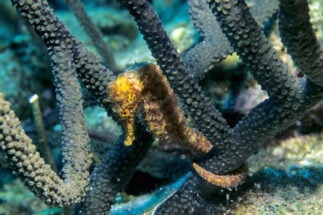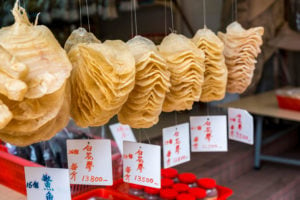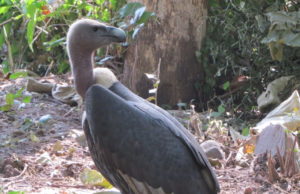On 19 July 2018 Daquan Zhen boarded a flight in Belize bound for Shanghai, passing through Mexico City. When Zhen checked his luggage at Mexico City International Airport, customs agents noticed a strong smell of fresh fish.
On searching Zhen’s suitcase officials found six black bags containing 81 seahorses, sea cucumbers, and swim bladders belonging to unidentified fish. The majority of these marine species that leave Mexico are used in traditional Chinese medicine (TCM), owing to their supposed aphrodisiac properties. Seahorses are crushed and ingested in soups or in wine to improve kidney function, to balance the Yin-Yang and to treat male impotence and female infertility.
Did you know…
Seahorses, sea dragons and pipefish are the only species of fish that swim upright
Mainland China is the world’s top consumer of seahorse, buying some 500 tonnes per year. Although the export of seahorses from Mexico without the proper permits carries up to nine years in prison, trafficking to Asia has escalated in recent years, enabled by incompetence and impunity on both sides of the trade. There have been no dried seahorses imported legally from Mexico since a ban came into effect in 2012.
Between 2001 and 2019, traffickers attempted to smuggle 95,589 seahorses out of Mexico, according to the Federal Environmental Protection Agency (Profepa). However, it is likely that the real figure is much higher given that there is considerable underreporting from Mexican authorities.
Of this total, 64% were destined for Hong Kong, Beijing and Shanghai. The rest went to the local Mexican market, records of Profepa seizures obtained by Diálogo Chino under Mexico’s Transparency Law show.
Chinese demand for seahorses remains high despite difficulties in obtaining permits to trade them legally. Traffickers often route them via Hong Kong, where rules are more lax and traders have established routes that smuggle them into mainland China.
Smuggling seahorses: Zhen’s Trial
Zhen appeared on 19 July before Judge Angélica Lucio and admitted to committing an environmental crime. He was placed in pre-trial detention. In Mexico, seahorses are listed as species Subject to Special Protection under the General Law of Ecological Balance and Environmental Protection and the General Wildlife Law. They are also named in article 420 of the Federal Penal Code and feature in the Second Appendix of the Convention on International Trade in Endangered Species of Wild Fauna and Flora (CITES), to which Mexico is a party.
Few traffickers such as Zhen receive more than a fine. On this occasion, however, Judge Lucio ordered that he be held in Reclusorio Sur, a prison located on the outskirts of Mexico City that houses 4,594 inmates, many of whom serve sentences for homicides, sexual violence, robbery, extortion and organized crime. According to case files obtained by Diálogo Chino, the prosecution had sufficient evidence to send Zhen to prison. Compensation for the crime was set at US$22,696.
The judges are inclined not to convict because it seems too harsh for someone to go to jail for having turtle eggs or totoaba guts or sea horses
However, the trial was resolved by commuting Zhen’s punishment. Prosecutors replaced his sentence with a fine and warned him never to return to Mexico. The penalty was reduced to US$6,600 and he was released despite the fact that he was found guilty of trafficking for commercial purposes.
Israel Alvarado, former director general of Federal Crimes against the Environment and Litigation at Profepa, said that these types of cases almost always end in this way due to corruption and the lack of training of Profepa staff, the Public Ministry and the judges.
“The judges are inclined not to convict because it seems too harsh for someone to go to jail for having turtle eggs or totoaba guts or sea horses,” Alvarado said.
Zhen’s is just one of 56 cases brought by Profepa following seizures of seahorses, according to the database. Of these fifty, at least 36 occured at Mexico City International Airport, a major global transport hub.
Seahorse trafficking by air and sea
According to Sarah Foster, an expert on the global seahorse trade, dried seahorses are very easy to move across borders: “They are small and when they dry, they keep well for long periods of time. They often move with shipments of other dried seafood, or in personal luggage, or by other hard-to-detect routes.”
Foster adds that evidence suggests that the vast majority of dried or freeze dried seahorses that cross borders do so illegally, and are not managed or monitored, as required by CITES.
“A large amount are taken through DHL and other courier services,” said Alicia Poot, a researcher at Inapesca, Mexico’s National Fisheries Institute. “Only if the workers know it’s illegal is it reported, but mostly they do not know,” she added.
Seahorse exports are occasionally authorised for some commercial and aquaculture research purposes, providing parties have a management plan approved by environmental authorities, according to Abraham Huerta, a former official at the Baja California Fisheries Secretariat.
However, no permits are now issued for domestic or commercial consumption, which has helped push the trade underground.
Hong Kong epicentre
Weak oversight and law enforcement on the demand-side also allow the illegal seahorse trade to prosper. Partnering with Diálogo Chino, journalists from Hong Kong-based media HK01 visited stores in Hong Kong where the seahorses are sold, finding staff willing and eager to smuggle them into mainland China.
Seahorses can be easily found in Hong Kong’s dry seafood stores. They are high-priced products due to their limited supply. The price of 100 grammes of dried seahorses can vary between US$120 and $580 (between 900 and 1500 Hong Kong dollars), depending on the size and origin.
Their popularity is not reflected in data from Hong Kong’s Census and Statistics Department, which shows a clear decline in legally imported dried seahorses over the past decade. Numbers have dropped in consecutive years since 2010, when nearly 8,000kg were brought in, to just 221kg in 2019.

Between 2009 and 2011, Hong Kong reported a sudden spike in the seahorse trade with Mexico compared to previous years. In the two-year period, sales jumped from 200kg to 900kg, equivalent to 250,000 seahorses. Mexico did not report these figures to CITES and has never explained the discrepancy, according to Foster.
Don’t bring it to mainland China yourself. Customs will arrest you. We have ways you don’t need to know or worry about.
Unlike selling locally in Hong Kong, the export of dried seahorses to mainland China requires licenses, which can put off potential sellers.
“Don’t bring it to mainland China yourself. Customs will arrest you,” a salesperson at a dry seafood shop in Mong Kok, a major Hong Kong commerce center, can be heard saying in a covert filming. “We have ways you don’t need to know or worry about. We have customers in mainland China,” he added.
The seller also claimed that their dried seahorses come mainly from the Americas, including Mexico, and are imported by suppliers of medicines to the TCM industry. The staff explained that a delivery service can be provided for an additional fee of HK $200 (US$26) but that no regular couriers would take the order.
Did you know…
There are believed to be up to 71 different species of seahorse, of which four inhabit the Mexican seas
“It is not easy to cross the border with goods. We have to seek the help of others. Anyway, we have our own ways. You know, we still have to supply products to restaurants in Shenzhen,” said the seller.
“There is no way you can send dried seahorses to mainland China using the proper procedures. The only way to do it is by trafficking,” said another owner of a dry seafood shop in Sheung Wan district.
The owner explained that applying for export licenses involves heavy taxes, but that he could offer help: “I can help you fix this, no matter what asset it is. If people are willing to take your money, it can be done.”
Traditional Chinese Medicine drives demand
According to Zhang Shiping, associate professor at Hong Kong Baptist University School of Chinese Medicine, TCM believes that seahorses help strengthen the kidney and balance the Yin-Yang.
“It works thanks to seahorses’ sex hormones. The sex hormones in our body decrease due to aging, so older people may need to take them,” said Zhang.
They can lift the bans and take steps towards a legal and sustainable trade. For the seahorse trade, at least, there are tools to do it correctly
Although some TCM practitioners prescribe seahorses, Zhang stressed that culinary uses – in soup or wine – are more common in Hong Kong and mainland China and have fewer side effects.
Zhang also said that seahorses can be substituted for some herbs that share similar healing properties, But while substitute products are encouraged, demand endures.
For Foster, bans on the seahorse trade aren’t working and high costs and difficulties in obtaining permits for their legal sale, in Mexico, Hong Kong and Mainland China serve only to encourage an illicit trade. In the absence of effective enforcement measures, the very least parties could do is ensure the trade works within the existing international framework for the protection seahorses.
“They can lift the bans and take steps towards a legal and sustainable trade. For the seahorse trade, at least, there are tools to do it correctly.”








![Avalanche rescue training in Chitral [image courtesy: AKAH-P]](https://dialogue.earth/content/uploads/2021/02/Avalanche-rescue-training-Yarkhund-Last-Chitral-300x225.jpg)